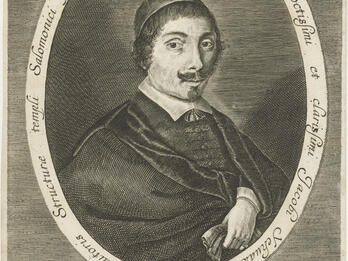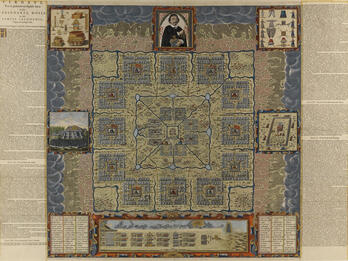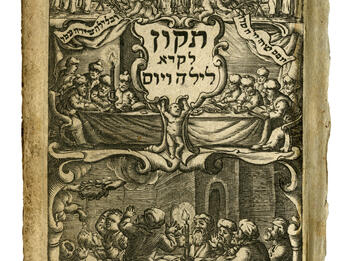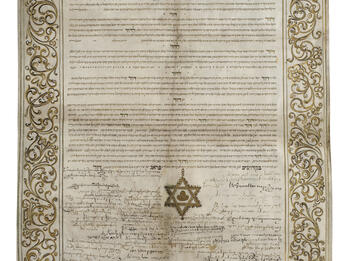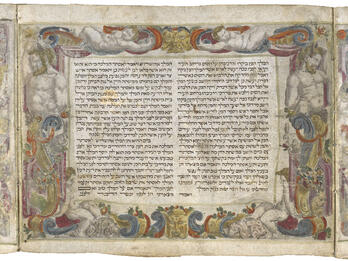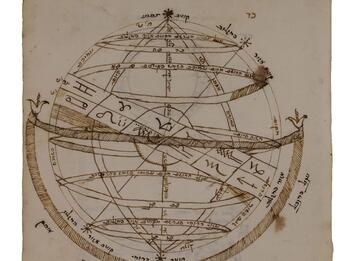Shete yadot (Two Hands): Or Torah (The Light of Torah)
The first “finger”1 is called Or Torah (The Light of Torah), as it consists of my notes on the Torah. Now, these notes will be useful for all people, but will provide their fullest benefit only to those who have in their possession the second Bomberg edition of the Rabbinic Bible, or the smaller Bomberg Bible of 5304 [1544]. This is because I have examined these two editions and inspected them letter by letter, with their vowels and cantillation marks, and I have corrected everything, including the plene and defective spellings and open and closed paragraphs. I have not seen other editions, however, and therefore it is possible that they contain other errors. Wherever you find a Sephardic volume, they are edited and dependable; one can rely upon them. And I will take for me faithful witnesses to record (Isaiah 8:2)—this is what the Ra’avad [Abraham ben David (ca. 1125–1198)] of blessed memory wrote in his comments on Sefer ha-ma’or, [Book of the Light, by Zeraḥyah ha-Levi of Girona (ca. 1115–ca. 1186)] at the end of the first chapter of Tractate Berakhot: even if this version seems a bit far-fetched, it is best to preserve it, as it is a Sephardic version. Likewise, the Ramban [Naḥmanides (1194–1270)] of blessed memory, in Sefer milḥamot [ha-shem (Book of the Wars of the Lord)], at the end of ninth chapter [of Berakhot] wrote as follows: but the Sephardic volumes are more reliable than ours.
I edited on the basis of ten or more manuscripts, none of which was written for a hundred gold coins, and some are ancient, as much as five or six hundred years old. I was also guided by several manuscript traditions and also a book by the Ramah [Meir Abulafia (1170–1244)]: Masoret seyag la-Torah, as well as Kiryat sefer, written by Menaḥem ha-Meiri [1249–1315], and ‘Et ha-sofer [Pen of the Scribe] of the Radak [David Kimḥi (1160–1235)],2 and Shemen Sasson [Joyful Oil, by Joseph Sasson (16th century)], and other works. Therefore, when someone has any question regarding anywhere in the Bible, if he asks me, I will clarify his difficulty for him, with God’s help, especially if I am at home.
Here is the text of the letter written and signed by all the scholars of Constantinople, praising and approving this work:
We have surely seen the works of God, the labor of heaven, performed by the scholar, the honorable R. Menaḥem Lonzano—may his light shine—on the Torah and the divine service. For he has taken it upon himself to compose many volumes of the Torah, Prophets, and Writings, all written in truth and integrity, clear of errors involving defective and plene words. Such mistakes can be found in volumes from the near and distant past—there are so many inaccuracies in them that it is simply unbelievable. Although we do have traditions in this regard, which are written down in many manuscripts and printed books, nevertheless many errors have crept into those volumes as well. This scholar is very alert and examines and investigates the truth of the Torah on the basis of scribes and books. His wisdom also stood him in good stead [see Ecclesiastes 2:9] to analyze and clarify the right and the good (Deuteronomy 6:18), the traditions of the written form of words and how they are to be read; to seek and to search out (Ecclesiastes 1:13) the words of the tradition; to discern through the strength of his acumen which is the right path for man to choose for himself [m. Avot 2:1]. Thus, one who examines his words will see how wonderful his counsel is and how great is his wisdom [see Isaiah 28:29]. There is no doubt that his recompense awaits him [see Isaiah 40:10] and that God designed this for the good [see Genesis 50:20], and behold his reward is with him [see Isaiah 40:10] in accordance with the magnitude of this mitzvah, for it is great.
Consequently, this matter is established by God [see Genesis 41:32] that everyone should assist in this labor of heaven, and it behooves all members of Israel to strengthen him in this entire work so that it will be accomplished. We therefore request from anyone who has in his possession an old volume lying in the corner to lend it to this scholar, so that he can use it for this whole labor of heaven which he is performing until he can complete it, for there is much work to be done. We especially implore the holy congregation of Jerusalem that they should provide him with those dedicated books of that congregation for as long as he requires them for his labor. Similarly, the holy congregations of Damascus and Aleppo, may the Lord protect them, who are rumored to possess ancient volumes, will be considered charitable [see Genesis 15:6] if they were to lend them to him, as stated above. Whoever withholds such kindness from him, by refusing to give him those books he holds, whether these are in the possession of an individual or have been dedicated to the congregation and are not owned by anyone in particular, the sages are displeased with them. May the blessed Lord send His assistance from the holy place to this scholar and accomplish that which concerns him [see Psalms 138:8] and spare him from errors, and may He speedily in our days fulfill for us the verse which states: for out of Zion shall go forth the Torah, and the word of the Lord from Jerusalem (Isaiah 2:3).
Meir N. Shanji; “the pauper from the dust,” Elijah ben ḥayim; Gedaliah ḥiyun; the small Eleazar, son of the honorable R. Hadriel ben Nahmias; “sold as a slave,” Hananiah ben Yakar; the young Menaḥem, son of the honorable R. Benjamin ha-Levi Ashkenazi, may his memory be for the life of the world to come; Moses Meshullam, son of the honorable R. Eliezer ha-Levi, may his memory be for the life of the world to come; ḥayim Shulam; Isaac Ya‘avetz.
The First “Finger”
Or Torah
Be-re’shit (“In the beginning”; Genesis 1:2): the letter bet is enlarged and has a diacritic dot in it, and the cantillation mark of the word is a tirḥa. The custom of scribes is to render the enlarged letter level with the other letters of the word on the top, with the additional part of the large letter extending below the other letters down the length of the line. However, the Zohar, page 109b, refers to the large letters that are above all the other letters, etc., which implies that one should do the opposite, i.e., that they should protrude on top.
Yehi (“let there be”; Genesis 1:3): has the shofar cantillation mark, not a makaph. This was the first dispute between Ben Asher and Ben Naphtali,3 as Ben Asher read yehi with a shofar, whereas Ben Naphtali read yehi with a makaph. The custom of all Jews in these regions is to rely on the readings of Ben Asher, as though a heavenly voice had emerged and declared that with regard to disputes between Ben Asher and Ben Naphtali the halakhah is in accordance with Ben Asher [see b. Eruvin 13b]. And although this dispute does not appear in the printed traditions, I found that in two manuscript traditions, as well as six Sephardic books, yehi was written with a shofar; it was found with a makaph only in Ashkenazic books and these are unreliable.
The first deshe’ (“grass”; Genesis 1:11) has the zakeph katan cantillation mark in one Ashkenazic book, and this appears to be correct, as it is typical for a zakeph katan to follow a pashta. However, in Sephardic books it has a revi‘a, and the Radak states the same in his work ‘Et ha-sofer.
Zar‘o bo (“in which is its seed”; Genesis 1:11): both of these words have a makaph, without a ma‘arikh.
Li-me’orot (“for lights”; Genesis 1:15) is plene, with regard to the first vav.
U-le-havdil (“and to divide”; Genesis 1:18): the vav has a ga’ya note, while the lamed has a sheva vowel, which is followed by a pataḥ, and R. Meiri, of blessed memory, attests likewise. The word’s cantillation mark is a zakeph katan.
And God said: let the waters swarm (Genesis 1:20): this begins an open paragraph.
The letter gimel in the word ha-gedolim (the great) contains a diacritic dot; ‘of (“bird”; Genesis 1:21) is plene, while yerek (“herb”; Genesis 1:30) has six dots for its vowels.
Notes
[I.e., subsection of each “hand” (section) of the book.—Trans.]
[All these are works on the rules of Torah writing.—Trans.]
[Two Masoretes from the ninth or tenth centuries CE.—Trans.]
Credits
Published in: The Posen Library of Jewish Culture and Civilization, vol. 5.



